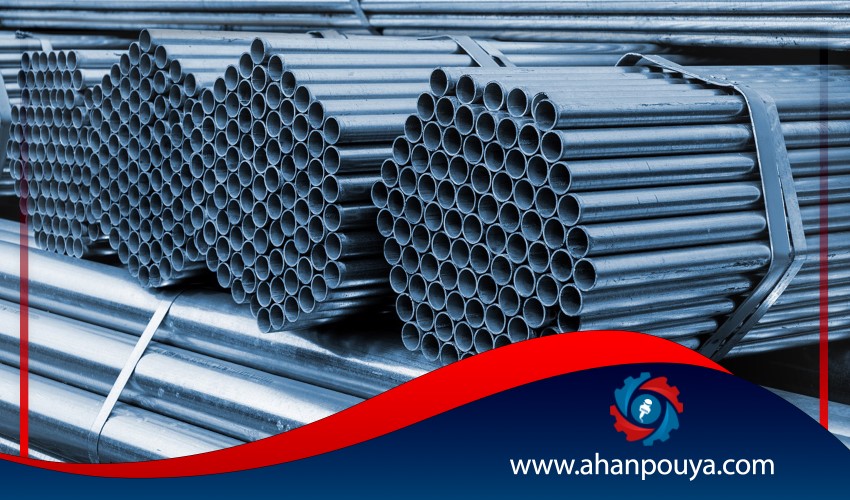
Iron is a chemical element Which is in the periodic table with the symbol Fe and atomic number 26. Iron is a metal that is in group 8 and period 4 of the periodic table.
Iron is one of the most common elements in the earth, making up about 5% of the earth's crust. Iron is extracted from hematite ores, which are mainly Fe2O3. The metal is separated by a reduction method with carbon, which is a more reactive element. This practice is carried out in a high furnace at approximately 2000 _ C . In 2000, approximately 1,100 million tons of iron ore were mined, with a trade value of approximately US $ 25 billion . Whereas the mining of iron ore takes place in 48 countries ، China, Brazil, Australia, Russia and India are the top five producers with 70% of the world's iron ore. 1100 million tons of iron ore are needed to produce approximately 572 million tons of crude iron.
The mass of a typical iron atom is 56 times the mass of a normal hydrogen atom. It is believed that iron is the tenth most abundant element in the world . This metal is extracted from iron ore and is rarely found in the free (elemental) state. In order to provide elemental iron , its impurities have to be removed by the chemical reduction method . Iron is used to produce steel. The nuclei of iron atoms have the highest cohesive force per nucleon.
iron application exceeds all metals And accounts for 95% of the metals produced worldwide . Its cheap price and high strength make its use inevitable, especially in cars, large ship hulls and buildings. Steel is the most famous iron alloy and a number of iron species are as follows :
1.Crude iron, which contains 5% -4% carbon and varying amounts of impurities such as sulfur, silicon and phosphorus, is important only because it is in the middle stage of the path from iron ore to cast iron and steel.
2.Cast iron contains 3.5% -2% carbon and a small amount of manganese. Cast iron is very strong, hard and brittle. The cast iron used, even white heat cast iron, breaks objects.
3.Carbon steel contains 1.5% - 0.5% carbon and low amounts of manganese, sulfur, phosphorus and silicon.
4.Wrought iron (soft iron) has less than 0.5% carbon and is a strong and malleable product. contains very small amounts of carbon.
5.Alloy steels contain varying amounts of carbon plus other metals such as chromium, vanadium, molybdenum, nickel, tungsten and.
6.Iron oxides are used to make magnetic storage in computers. They are often mixed with other compounds and retain their magnetic properties in solution.
Gamma iron is one of the iron allotropes that is stable in the temperature range of 912 to 1394 degrees Celsius. It has a crystal (fcc cubic center).
2.What is Delta Iron?
delta iron is one of the iron deposits Which is stable from 1401 ° C to 1539 ° C (melting point). Delta iron has a center-filled cubic crystal structure. Delta iron has paramagnetic properties. the constants of the delta iron lattice , respectively.
3.What is alpha iron ?
Alpha iron is one of the allotropes of iron. This allotrope is stable from -273 ° C to 910 ° C. This allotrope has a center-filled cubic crystal structure. the constants of fe in the ferromagnetic / ferromagnetic alpha lattice , respectively .
At 768 ° C, ferromagnetic alpha iron is converted to paramagnetic alpha iron. The lattice constant of this type of iron is 2.9 angstroms.
The term steel is used for iron alloys that have between 0.025 and about 2% carbon. Alloy steels are often associated with other metals. The properties of steel depend on the percentage of carbon in it, the heat treatment performed on it and the alloying metals in it.
Steel, which has up to 0.2% carbon, is used to make steel wires, pipes, and sheets. Steel has an average of 0.2 to 0.6 percent carbon and use it to make tracks , boiler and building parts . Steel with 0.6 to 1.5 percent carbon is hard. it is used to make instruments , springs , knives and forks .
The iron that comes out of the blast furnace is called cast iron It contains amounts of carbon, sulfur, phosphorus, silicon, manganese and other impurities. two objectives are followed in steel production :
Burning of cast iron impurities
Add certain amounts of alloying agents to iron
Manganese, phosphorus and silicon are oxidized in molten cast iron by air or oxygen And with the help of a proper melting compound, they come out as slag. Sulfur enters the slag as sulfide, and carbon burns to form carbon monoxide (CO or carbon dioxide) (CO2). If the main impurity is manganese, an acid melting aid, usually silicon dioxide (SiO2), is used.
Rust is a common name for one of the most common compounds, iron oxide with the formula Fe2O3. This name is common. because iron is quickly combined with oxygen And forms iron rust. In fact, iron can rarely be found in pure form in nature. Iron (or steel) rust is an example of a corrosion process.
Refined molten iron is converted to steel by adding a certain amount of carbon and alloying metals such as vanadium, chromium, titanium, manganese and nickel. Special steels may contain molybdenum, tungsten or other metals. such steels are used for specific purposes . at high temperatures , iron and carbon got together. Whenever a steel containing cementite cools slowly, the above equilibrium shifts to the formation of iron and carbon, and the carbon separates into graphite flakes. This mechanism is more important in cast irons, which have a higher percentage of carbon.

Ahan Pouya with more than a decade of best-selling experience, adheres to professional and ethical principles in the field of selling and buying at inside and outside the borders of Iran, helping you in the steel industry.